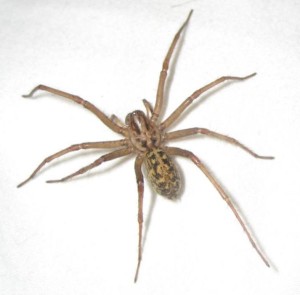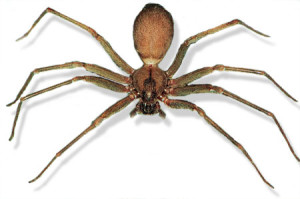The Hobo Spider
 Accidentally introduced to the western United States in the early 80’s, the aggressive house spider or “Hobo Spider” is found commonly in Washington, Oregon, Idaho, and Utah. Originating from Europe, this common spider is from the Family Agelenidae, a type of spider that constructs funnel webs. This spider is brown, and commonly mistaken for other spiders, including the wolf spider. Hobo spiders feed on many types of insects. They use their funnel-like webs to attract insects, which creates vibrations in the web. These vibrations are felt by the hobo spider and they immediately attack the unsuspecting bug. After killing the prey, the hobo spider brings it into the narrow end of the funnel to consume its prey. The nest also acts as a mating ground. Females remain in their nests after mating while males will either die soon afterward or move on to a new nest.
Accidentally introduced to the western United States in the early 80’s, the aggressive house spider or “Hobo Spider” is found commonly in Washington, Oregon, Idaho, and Utah. Originating from Europe, this common spider is from the Family Agelenidae, a type of spider that constructs funnel webs. This spider is brown, and commonly mistaken for other spiders, including the wolf spider. Hobo spiders feed on many types of insects. They use their funnel-like webs to attract insects, which creates vibrations in the web. These vibrations are felt by the hobo spider and they immediately attack the unsuspecting bug. After killing the prey, the hobo spider brings it into the narrow end of the funnel to consume its prey. The nest also acts as a mating ground. Females remain in their nests after mating while males will either die soon afterward or move on to a new nest.
Do they bite? These spiders are very protective of their nests and eggs. They will attack if provoked, however, recent data has scientists suggest that hobo spiders are not medically dangerous, meaning their bite does not need medical treatment. However, the bites delivered from Hobo spiders are very painful. Symptoms include a slight prickling sensation, and a small, numb, hard area 30 minutes after the bite. A necrotic lesion may form and can range from 1/2 to 1 inch or more in diameter and take several months to heal.
The Brown Recluse Spider
Native to the midwest United States, the Brown Recluse Spider is a fairly well-known pest that is dangerous to humans. However, it is rarely aggressive and bites are very uncommon. In 2001, more than 2,000 brown recluse spiders were removed from a heavily infested home in Kansas, yet the four people who had lived there for years were never harmed by the spiders, despite many encounters with them. These spiders dwell in dark, sheltered places and can be found in homes, barns and basements. Webs are built mostly on ground level. The spider is a hunter, so the web is not designed to catch prey but instead, they roam around searching for prey.
A common myth about these spiders are that they are found everywhere in the U.S., but studies have shown otherwise. Brown recluse spiders are only in the American South and Midwest. Sometimes they can stow away in boxes or items moved from its native range. These usually are random and don’t cause the spread of habitat. Another common mistake is that some conditions are mistakenly diagnosed as brown recluse spider bites, including Lyme disease, diabetic ulcers, reactions to medication, and bacterial infections. A final common confusion regarding these spiders is that they are often mistaken for other spiders. Brown recluses have uniformly colored legs and abdomens, so any spider exhibiting distinct color variations and patterning on the legs or abdomen is not a brown recluse. They are referred to as ‘fiddleback spiders’ due to a distinctive marking on the thorax, which resembles a violin.
If you see these potentially dangerous arachnids in your home, leave them to pest control professionals. We will help you feel safe in your home again. Don’t hesitate to call ProActive Pest Management at 630-451-8101.

